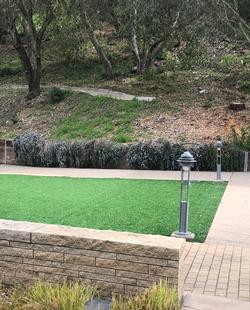Spring 2023
Synthetic Turf: a UC Master Gardeners Perspective
by Laurinda Ochoa

We receive questions about synthetic turf lawns at our Ask A Master Gardener tables. With rising costs of water, fertilizers and garden maintenance, many people wonder if it is a good idea to take out their lawns and put in an artificial turf product. From a UC Master Gardeners volunteers’ perspective, the answer is No. Synthetic turf is not a good substitute for our lawns.
Currently, the East Bay Municipal Utility District (EBMUD) does not provide consumer rebates for artificial turf lawn conversions, while the Contra Costa Water District (CCWD) limits their use to 20% of the rebated area with a requirement that 50% of the total converted area be covered with plants. A quick internet search shows some US cities are now banning new installations of synthetic turf, and national sports organizations are moving away from synthetic turf surfaces to protect against athlete injuries.
Why isn’t synthetic turf a good alternative for our yards? Karrie Reid is a horticultural scientist and educator who trains UC Master Gardener volunteers and city employees throughout California on environmentally friendly landscape practices. She has conducted studies and reviewed the literature, and found that:
- Synthetic turf can have exceedingly high surface temperatures in the summer and fall which can cause burns on children and pets,
- It is not maintenance free, and needs to be washed with soap and water to prevent foul odors, the infill replaced, and the blades brushed or raked,
- It does not provide environmental benefits and actually kills organisms that contribute to healthy, permeable soils,
- It has a huge petroleum-based carbon footprint,
- It may be made with recycled rubber containing toxic metals, and
- It’s currently not recyclable so it ends up in landfills within 10 years (on average), which adds to micro-plastic pollution of our soil and water.
For families with children and pets, it is particularly important to be aware of how quickly the synthetic turf surface can reach temperatures that burn skin, feet and paws. A UCANR study from 20211 found that surface temperatures on artificial turf in July “reached over 165 degrees F in Palm Springs and 159 degrees F in Redlands on days when the air temperatures were, respectively, 113 and 108 degrees F.” Another study from Brigham Young University found when outdoor ambient temperatures were between 90 - 100 degrees, an increasingly common temperature for our inland areas, the surface temperature of synthetic turf can approach 200 degrees. Spraying down the hot turf can cool the surface, but this is a temporary fix that only lasts for five to twenty minutes, and wastes water.
We know living plants and trees cool their surrounding environment and help protect our residential and urban areas from the increasingly high temperatures associated with climate change. Although lawns, plants and trees require watering during periods of high heat, there are heat resistant and drought tolerant lawn grasses, ground covers, mulches and trees that provide environmental benefits without the harmful effects and high costs of installing and maintaining synthetic turf lawns.
References:
- Drought Tolerant Native Groundcovers, by Kate Verhoef and Laurinda Ochoa.
- Synthetic turf, dark mulch and asphalt surfaces are superheating our inland cities by Janet Hartin. Published by UCANR, July 30, 2021.
